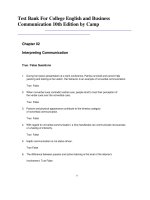Test bank for abnormal child and adolescent psychology 7th edition by wicks nelson
Bạn đang xem bản rút gọn của tài liệu. Xem và tải ngay bản đầy đủ của tài liệu tại đây (54.5 KB, 8 trang )
Full file at />
CHAPTER 1
INTRODUCTION
TRUE OR FALSE
1.
Ab means “away” or “from,” whereas “normal” refers to “average” or “standard.” Thus
abnormal is defined as something the deviates from the average.
2.
Age is an important developmental index in judging behavior.
3.
Sociocultural norms for behavior rarely change.
4.
Ethnicity and race are terms for the same concept.
5.
A child’s behavior should not vary by situation whether it be in the classroom, the playground, or
at home.
6.
Schizophrenia is a disorder that typically first occurs in childhood.
7.
Psychiatrists earn an M.D. and psychologists earn a Ph.D.
8.
In most cultures boys are expected to be less active and aggressive than girls. This expectation is
an example of a situational norm.
9.
Youth rarely refer themselves for clinical evaluation.
10.
Population studies indicate that 5 to 10 percent of youth display some kind of clinic-level
behavioral disorder.
11.
Quantifying the prevalence of disorders is difficult because it depends on several factors,
including the definition of disorders, the population examined, and the methods used to identify
the problem.
12.
Changing social conditions may increase the risk of disorders in young people.
13.
Early disturbances, for example, feeding or sleep disorders in infancy, do not have developmental
consequences.
14.
One difficulty in establishing the age of onset of behavioral disorder is that disorder may only
gradually occur so that age of onset may be a rather arbitrary indicator.
15.
Esther and Anthony are in Mr. Michaels’s third grade class. Esther is asked to stay in at recess for
being inattentive during reading. Anthony is referred to the principal’s office for talking during
reading circle. This is an example of gender bias that can influence gender-specific prevalence
levels.
buy this full document at
Full file at />16.
One explanation for differing rates of behavioral disorder in boys and girls is a gender difference
in disruptive behavior, which can result in a gender difference in referral for clinical services.
17.
The conceptualization of adolescence as a distinct period of life took hold in the 17th and 18th
centuries.
18.
Somatogenesis refers to the belief that behavioral disturbance results from a person’s being
possessed or influenced by devils or some similar force.
19.
Demonology refers to the belief that mental disorder can be attributed to bodily malfunction or
imbalance.
20.
Kraepelin is credited with a system to classify mental disturbances that served as the basis for
modern classification systems.
21.
Freud contributed to the field of childhood behavioral disorder by emphasizing the importance of
early, unresolved psychological conflicts in the development of problems.
22.
Behavior modification or behavior therapy is the explicit application of learning principles for the
assessment and treatment of behavioral problems.
23.
Longitudinal studies, focusing on normal development, assisted in the understanding and study of
child and adolescent disorders.
24.
Anna Freud, a mother and visionary, advocated to establish a Child Welfare Station at the
University of Iowa.
MULTIPLE CHOICE
25.
Joe is in the second grade and cannot stay focused. He is not reading and tests below grade level
in all subjects. He is rarely in trouble at school or at home. Joe
a.
b.
c.
d.
26.
Which is least likely to be considered an indication of problem behavior in youth?
a.
b.
c.
d.
27.
is free from all behavior disorders.
may have a behavioral disorder and should be evaluated.
is a typical boy.
is none of the above.
A behavior is excessively intense.
A behavior is qualitatively atypical.
A behavior is unusual but of no harm to anyone.
A behavior is exhibited in inappropriate settings.
Concern that a child is displaying disordered behavior may be based on
a. parental intolerance of atypical behavior.
b. developmental norms.
buy this full document at
Full file at />c. gender stereotypes.
d. all of the above.
28.
Which is generally true about behavioral disorders of youth?
a.
b.
c.
d.
29.
There is some relationship between the onset of specific disorders and the age of youth.
About 50 percent of youth with problems receive adequate treatment.
Disorders are best viewed as located within individuals.
Overall, girls display higher rates than boys.
Alicia’s mother is worried because although Alicia’s behavior seems much like that of her peers,
Alicia misbehaves relative to the setting she is in. Alicia’s mother is concerned that her daughter
is not meeting
a. gender norms.
b. situational norms.
30.
The Weisz et al. (1988) study of adults' concerns about childhood behavioral problems suggests
that
a.
b.
c.
d.
31.
U.S. and Thai adults held identical beliefs.
U.S. adults were less concerned than Thai adults.
cultural differences influenced adult concerns.
gender norms were of critical concern.
Weisz et al. (1988) established that
a.
b.
c.
d.
32.
c. regression norms.
d. developmental norms.
the universality of behavioral expectations exists regardless of culture.
social and cultural norms are influenced by institutional factors such as religion.
both A and B
none of the above.
About what percent of youth with behavioral disorders is thought to receive adequate treatment?
a. 80 percent
b. at least 65 percent
33.
c. less than 33 percent
d. less than 15 percent
What percent of children and adolescents is estimated to have clinic-level behavioral problems?
a. about 60 percent to 70 percent
b. about 50 percent
34.
c. about 33 percent
d. about 15 percent to 20 percent
Which is false regarding the prevalence of behavioral disturbance of youth?
a. It is estimated that one-half of youth have clinic-level disorders.
b. It is estimated that one-third or less of youth needing care actually receive care.
c. Prevalence rates are thought to vary across populations partly because methods of data
collection vary.
d. Prevalence rates are thought to vary across populations partly because disorders are defined
differently.
buy this full document at
Full file at />35.
With regard to childhood behavioral problems and age of youth,
a. little relationship exists between age and the occurrence of problems.
b. sometimes what seems to be a relationship between age and the occurrence of a specific
disorder may actually reflect the time at which the disorder is first identified.
c. almost all behavior problems of young people appear in some form by age six.
d. b and c above.
36.
With regard to the rates of behavioral disorders,
a.
b.
c.
d.
37.
boys and girls show about the same rates.
boys show fewer anxiety problems than girls.
boys show less acting-out aggression than girls.
none of the above.
Which is false regarding gender and rates of behavioral disorders?
a. Data drawn from clinic samples provide the most accurate information about gender
differences.
b. For some disorders, the definition of the disorder may differentially influence gender rates.
c. The tendency for adults to have relatively low tolerance for acting-out behavior may be
related to some gender differences in rates of disorder.
d. All of the above.
38.
The concept of childhood as a distinct time of life became important by the
a. 11th century.
b. 17th and 18th centuries.
39.
c. early 19th century.
d. late 19th and early 20th centuries.
The idea of adolescence as a distinct period of life took hold ______ the concept of childhood as
a distinct period.
a. at about the same time as
b. earlier than
c. later than
40.
Which of the following terms refers to biological causation of behavioral disturbance?
a. egogenesis
b. somatogenesis
41.
c. demonology
d. operogenesis
When the term syndrome is used in reference to a behavioral disturbance, it suggests that the
disorder
a.
b.
c.
d.
has a biological cause.
has a psychological cause.
occurs mostly in early childhood.
is characterized by a group of symptoms.
buy this full document at
Full file at />42.
Who is credited with publishing, in the 19th century, an important classification system for
mental disorder?
a. Freud
b. Myers
43.
In the case of “Little Hans,” Freud proposed that fear and anxiety had their basis in Hans’s
a.
b.
c.
d.
44.
48.
overstimulation.
understimulation.
recognizing one’s own unacceptable impulses.
seeking immediate sexual gratification.
In contrast to Sigmund Freud, John Watson argued for
a.
b.
c.
d.
47.
founded Chicago’s Juvenile Psychopathic Institute.
founded the first U.S. child psychology clinic, at the University of Pennsylvania.
invited Freud to lecture at Clark University.
extensively studied children’s development at Yale University.
In Freudian theory, defense mechanisms are viewed as protecting the individual from
a.
b.
c.
d.
46.
desire to have a mustache and wear glasses like his father.
wish for more attention from his father and his mother.
desire to own a horse.
sexual impulses toward his mother and fear of his father.
G. Stanley Hall is known as the person who
a.
b.
c.
d.
45.
an emphasis on internal psychological conflicts.
the study of biological influences on behavior.
an emphasis on learning experiences.
a stage theory of development.
The idea that behavior is shaped by its consequences is called _________ and was created by
______.
a. law of effect; Thorndike
b. psychoanalysis; Freud
c. classical conditioning; Watson
d. observational learning; Bandura
Which name does not belong with the others?
a. Thorndike
b. Binet
49.
c. Hillis
d. Kraepelin
c. Skinner
d. Watson
Who wrote the influential book, A Mind That Found Itself ?
a. Beers
b. Bandura
c. Hillis
d. Judge Baker
buy this full document at
Full file at />50.
The child guidance movement in the United States
a.
b.
c.
d.
51.
The theorist who linked the social context with cognition was
a.
b.
c.
d.
52.
Anna Freud.
Emil Kraepelin.
Skinner.
Bandura.
A __________ is a trusting, personal bond formed between the therapist and the client.
a.
b.
c.
d.
53.
was related to the establishment of the Orthopsychiatric Association.
was an outgrowth of behaviorism.
received its impetus from longitudinal studies of children begun around 1920.
was based on the work of Hall at Clark University.
confidentiality agreement
therapeutic alliance
treatment contract
working relationship
Who was the first president of the American Psychological Association?
a. Skinner
b. Gesell
54.
c. Hall
d. Beers
Who is best known for early efforts to evaluate children's intellectual functioning?
a. Binet and Simon
b. Healy and Bronner
c. Kraepelin
d. Beers
BRIEF ESSAY QUESTIONS
55.
What role do developmental norms play in defining disordered behavior of youth?
56.
Discuss three variables that influence whether a child or adolescent will be identified as “having”
a behavioral problem.
57.
Discuss the role that cultural and social standards play in defining disordered behavior of youth.
58.
What factors possibly contribute to creating gender differences in the prevalence of behavioral
disorders of youth?
59.
How can gender bias in clinic samples indirectly affect gender differences in the prevalence of
behavioral disorders?
buy this full document at
Full file at />60.
Discuss three aspects of Freud’s theory that framed his important view of psychological
disturbances in youth and adults.
61.
Briefly summarize the aims and early history of the mental hygiene and the child guidance
movements.
62.
List five themes (premises) viewed by the text authors as central to the current study and practice
of developmental psychopathology.
ANSWER KEY
1.
2.
3.
4.
5.
6.
7.
8.
9.
10.
11.
12.
13.
14.
15.
16.
17.
18.
19.
20.
21.
22.
23.
24.
25.
26.
27.
28.
29.
30.
31.
32.
33.
34.
35.
36.
37.
T,
F,
T,
F,
F,
F,
T,
F,
T,
F,
T,
T,
F,
T,
T,
T,
F,
F,
F,
T,
T,
T,
T,
F,
B,
C,
D,
A,
B,
C,
B,
C,
D,
A,
B,
B,
A,
p. 3, factual
p. 3, conceptual
pp. 4–6, conceptual
pp. 4–5, factual
p. 5, conceptual
p. 8, factual
p. 16, factual
p. 5, conceptual
p. 5, factual
p. 6, factual
p. 6, conceptual
p. 6, factual
p. 6, conceptual
p. 8, factual
p. 9, applied
p. 9, factual
p. 10, factual
p. 10, factual
p. 10, factual
p. 10, factual
pp. 11–12, factual
p. 14, factual
p. 15, factual
p. 16, factual
pp. 2–3, applied
p. 3, factual
pp. 3–5 conceptual
pp. 7–8, factual
p. 5, applied
p. 4, factual
p. 4, factual
p. 6, factual
p. 6, factual
p. 7, factual
pp. 7–8, conceptual
pp. 8-9, factual
p. 9, conceptual
buy this full document at
Full file at />38.
39.
40.
41.
42.
43.
44.
45.
46.
47.
48.
49.
50.
51.
52.
53.
54.
55.
56.
57.
58.
59.
60.
61.
62.
B, p. 10, factual
C, p. 10, factual
B, p. 10, conceptual
D, p. 10, factual
D, p. 10, factual
D, p. 12, factual
C, p. 11, factual
C, p. 12, conceptual
C, p. 13, conceptual
A, p. 13, factual
B, pp. 13-14, factual
A, p. 14, factual
A, p. 14, factual
D, p. 14, Factual
B, p. 17, factual
C, p. 14, factual
A, p. 15, factual
pp. 3–5, conceptual
p. 3, factual
pp. 3-5, conceptual
p. 5, factual
pp. 9-10, conceptual
pp. 11–12, factual
p. 14, factual
p. 15, factual
buy this full document at









